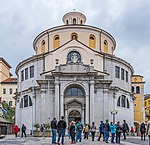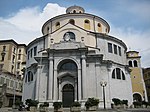Church of St. Nicholas, Rijeka
1790 establishments in the Holy Roman Empire18th-century Serbian Orthodox church buildings18th-century churches in CroatiaBuildings and structures in RijekaChurches completed in 1790 ... and 4 more
Croatian building and structure stubsCulture in RijekaEuropean church stubsSerbian Orthodox church buildings in Croatia

The Church of St. Nicholas (Serbo-Croatian: Crkva svetog Nikole / Црква светог Николе) is a Serbian Orthodox church in Rijeka, Croatia. The church is dedicated to Saint Nicholas. The building of the church was completed in 1790.
Excerpt from the Wikipedia article Church of St. Nicholas, Rijeka (License: CC BY-SA 3.0, Authors, Images).Church of St. Nicholas, Rijeka
Ignazia Henckea, Grad Rijeka Mjesni odbor Luka (Rijeka)
Geographical coordinates (GPS) Address External links Nearby Places Show on map
Geographical coordinates (GPS)
| Latitude | Longitude |
|---|---|
| N 45.3259143 ° | E 14.4427835 ° |
Address
crkva svetog Nikole
Ignazia Henckea
51101 Grad Rijeka, Mjesni odbor Luka (Rijeka)
Croatia
Open on Google Maps








